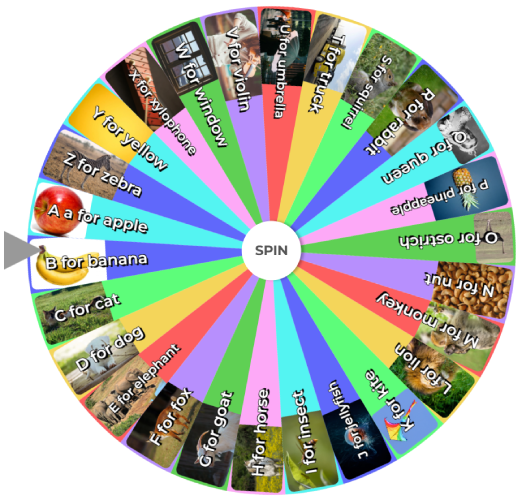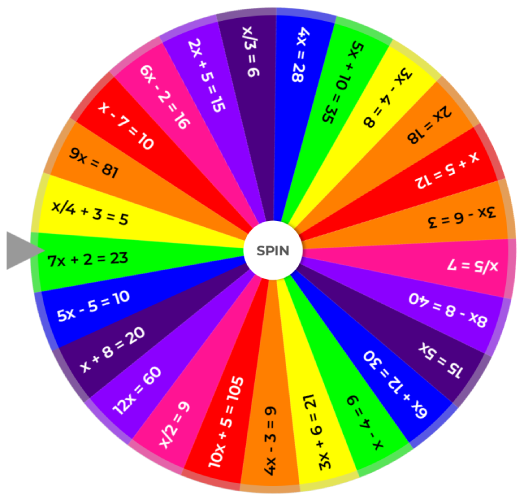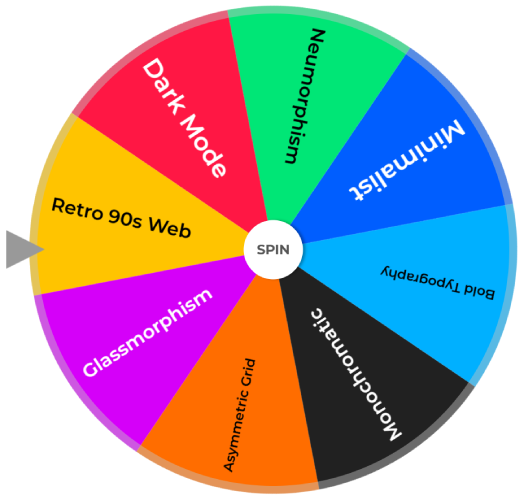Enter a name (optional)
Enter a description
Enter a name (optional)
Enter a description
Updated: June 30, 2025
The Dinosaur Wheel Spinner is an engaging way to randomly pick a type of dinosaur and see an image and facts about the selected dinosaur! It is a great way to learn about dinosaurs as well as being perfect for those with a special interest about dinosaurs who just love spinning the wheel. It reduces stress, acts as an online fidget, and can help ease anxiety through its soothing, repetitive action.
This interactive wheel spinner combines learning and fun by using a random wheel spin to select dinosaurs, making it an excellent tool for the classroom. Teachers can use it as a random name picker alternative, where each spin reveals a dinosaur image that can be clicked to open detailed facts. This encourages curiosity and active participation, helping students engage more deeply with the topic of dinosaurs.
The visual element of the wheel makes it especially effective for younger learners and those who benefit from interactive, image-based tools. It also works well as a digital fidget spinner, offering a calming, low-pressure experience that supports focus and reduces anxiety. The wheel can be saved and shared with students or friends, making it a flexible resource for group learning, personal exploration, or simply enjoying the thrill of the spin.

The Alphabet Letter Wheel is a completely free, interactive and engaging tool designed to help children learn the ABCs in a fun and engaging way. It can be used by teachers or parents and is fully customizable. The wheel can vocally read out loud the letters and objects beginning with that letter!

A free, fun spinning quiz wheel that selects random algebra questions. Ideal for practicing algebra, teaching students, or testing yourself on algebraic expressions.

Spin the Free Web Design Inspiration Wheel to generate web design themes and styles. Decide your next website layout or look.
The Dinosaur Picker Wheel by Random Wheel Spin is a fun, educational tool that uses a random wheel spin to select different types of dinosaurs. With vivid images and clickable entries, it makes learning about dinosaurs both interactive and exciting.
Some common applications of the Dinosaur Picker Wheel include:
The suspense and excitement of the spinning wheel adds surprise and delight, encouraging exploration and repeated use. It turns ordinary learning moments into immersive, curiosity-driven experiences.
The dinosaur picker wheel is a highly versatile classroom tool, combining fun and structure in equal measure. Designed by Random Wheel Spin, this wheel spinner captures student attention with colorful dinosaur images and clickable entries that reveal fun facts about each species.
Teachers can use the dinosaur picker wheel to randomly assign group roles (like "Team Triceratops" vs. "Team Stegosaurus"), quiz questions, reading activities, or rewards. It can be integrated into science lessons, storytelling sessions, or behavior management strategies.
This interactive random name picker alternative keeps students involved while adding excitement to daily routines. Each spin becomes a moment of engagement—ideal for younger learners and visual learners alike.
Features that support classroom use:
In addition to its educational value, the dinosaur picker wheel doubles as a digital fidget spinner. The smooth, repetitive motion of the random wheel spin provides a calming, satisfying experience for many students.
This can be especially helpful during classroom transitions, downtime, or when students need a sensory break. For students with anxiety or neurodivergent learners, watching the wheel spin can reduce stress and help them refocus.
The visual and interactive nature of the spinner keeps engagement high without overstimulation. Students often cheer or laugh as the wheel slows and lands on a dinosaur—turning a moment of tension into shared joy.
It’s not just a fun tool—it’s a way to support emotional regulation while keeping learning on track. For students with a special interest in dinosaurs, the wheel becomes a rewarding and focused digital outlet.
Yes, the Dinosaur Picker Wheel at Random Wheel Spin uses cryptographic Random Number Generation (RNG) to ensure every spin is completely random. This wheel spinner is both provably fair and securely designed.
Seeing the same dinosaur more than once is just chance at work. Just like flipping a coin or rolling dice, repetition is part of randomness. The wheel does not store previous results, so each spin is a new event.
The underlying system uses browser-based cryptographic randomness via crypto.randomUUID(), and hashing with SHA-256 to ensure security and fairness, matching standards used by financial and tech institutions.
Our spin counter updates in real time after each spin.
Total Spins: Loading...
Image credit for background image: DigitalRoo - Pixabay - CC license
Below are all the types of dinosaur featured in the wheel spinner above. If you have a favourite dinosaur that isn't on the wheel and want it added please let us know! You can contact us here.
Allosaurus lived around 150 million years ago during the Jurassic period. It was a fast, meat-eating dinosaur with sharp teeth and claws. It probably hunted plant-eating dinosaurs like Stegosaurus and may have worked in packs, like a team of hungry wolves!

Ankylosaurus lived about 68 million years ago during the Late Cretaceous period. It was a plant-eater covered in bony armor with a huge tail club for protection. It could grow as long as a school bus and may have lived up to 30 years!

Baryonyx lived about 125 million years ago during the Early Cretaceous period. It had a long crocodile-like snout full of sharp teeth and probably ate fish. It had a huge claw on each hand and may have even swum to catch its food. Fossils of this dinosaur were first found in England!

Brachiosaurus lived around 150 million years ago during the Jurassic period. It ate plants and used its long neck to reach the tallest trees—like a dinosaur giraffe! It was one of the tallest dinosaurs ever, as high as a four-story building, and may have lived up to 100 years! It weighed about three times heavier than the similar looking Brontosaurus and about twice the height of a Brontosaurus.

Brontosaurus lived about 150 million years ago during the Jurassic period. It was a huge, plant-eating dinosaur with a long neck and tail. It used its neck to reach low plants and leaves, and it may have weighed as much as five elephants!

Carnotaurus lived about 70 million years ago during the Late Cretaceous period. It was a meat-eating dinosaur with tiny arms, sharp teeth, and two small horns above its eyes—like a dino bull! It could run fast to chase its prey.

Coelophysis lived about 210 million years ago during the Late Triassic period. It was a small, meat-eating dinosaur with sharp teeth and a long, slender body. It was fast and hunted in packs, possibly eating insects, small animals, and even other dinosaurs. Fossils have been found in big bone beds, showing they may have lived in groups!

Corythosaurus lived about 77 million years ago during the Late Cretaceous period. It had a big, helmet-like crest on its head that looked like a fancy hat! It ate plants using hundreds of teeth. It wasn’t the biggest dinosaur but was one of the best at making sounds with its crest to talk to friends.

Dilophosaurus lived around 193 million years ago in the Early Jurassic period. It had two cool crests on its head that made it look like a dragon! It was a meat-eater and used sharp teeth to catch prey. It was not the biggest dinosaur but was one of the fastest runners for its time.

Diplodocus lived about 154 million years ago during the Late Jurassic period. It was super long—longer than a school bus—and was one of the heaviest dinosaurs, even heavier than Brachiosaurus! It ate plants with its long neck, reaching treetops. It was one of the longest dinosaurs ever!

Europasaurus lived around 154 million years ago in the Late Jurassic period. Unlike most huge dinosaurs, it was very small—about the size of a pony! It ate plants and lived on islands where food was limited. It’s famous for being a tiny, “dwarf” dinosaur!

Gallimimus lived about 70 million years ago in the Late Cretaceous period. It looked like a giant bird with a long neck and legs and could run super fast, almost like a cheetah! It ate plants and small animals. It was one of the fastest dinosaurs around!

Ichthyosaurus lived about 200 million years ago in the Early Jurassic period. It wasn’t a land dinosaur but a fish-like reptile that swam in the ocean! It looked like a dolphin and ate fish and squid. It was an amazing swimmer and could breathe air like whales today.

Iguanodon lived about 125 million years ago during the Early Cretaceous period. It was one of the first dinosaurs ever discovered! It had a big thumb spike that might have been used for defense. Iguanodon ate plants and could walk on two legs or all fours. It grew as tall as a horse and was one of the most common plant-eaters of its time.

Lirainosaurus lived around 70 million years ago in the Late Cretaceous period. It was a type of sauropod but much smaller than most, about the size of a cow! It had a long neck to reach plants but was shorter and stockier. Lirainosaurus lived in what is now Europe and was great at living in forests and eating tough plants.

Mosasaurus lived about 70 million years ago in the Late Cretaceous period. It was a giant sea reptile that could grow up to 50 feet long—bigger than a school bus! Mosasaurus was a fierce predator, eating fish, turtles, and even smaller sharks. It swam with powerful fins and had sharp teeth like a crocodile.

Parasaurolophus lived about 76 million years ago during the Late Cretaceous period. It had a long, curved crest on its head that acted like a trumpet to make loud sounds! It ate plants and could walk on two or four legs. Parasaurolophus was one of the coolest-sounding dinosaurs and could grow as long as a school bus!

Pterodactyl lived about 150 million years ago in the Late Jurassic period. It wasn’t a dinosaur but a flying reptile with wings made from skin stretched over a long finger. It had sharp teeth and ate fish from the ocean. Pterodactyls were among the first creatures to fly, soaring high like birds! The first "P" letter in its name is silent and the creature is actually pronounced "tero-dactyl". Their wing span could reach up to 11 metres, about the length of a bus, making them the largest known flying animals!

Silvisaurus lived about 100 million years ago during the Early Cretaceous period. It was an armored dinosaur, covered in bony plates to protect itself from predators. It was about the size of a small car and ate plants. Silvisaurus lived in forests and was one of the tougher dinosaurs around!

Spinosaurus lived about 100 million years ago in the Early Cretaceous period. It was one of the biggest meat-eating dinosaurs, even bigger than T. rex! It had a huge sail-like fin on its back, which might have helped it swim or stay cool. Spinosaurus loved to eat fish and probably spent a lot of time in the water, making it a unique dinosaur hunter!

Stegosaurus lived about 150 million years ago during the Late Jurassic period. It had big, bony plates on its back that looked like a giant fan and a spiked tail called a “thagomizer” for defense. Stegosaurus ate plants and was about as long as a school bus. It wasn’t very fast but had one of the coolest armored looks!

Triceratops lived about 68 million years ago in the Late Cretaceous period. It had three big horns on its face and a huge bony frill to protect its neck. Triceratops was a plant-eater and could grow as big as a truck! It used its horns to fight predators and was one of the last dinosaurs before the big extinction.

Tsintaosaurus lived about 70 million years ago during the Late Cretaceous period. It had a unique, long, spike-like crest on its head that looked like a unicorn’s horn! It ate plants and likely used its crest to make sounds or attract friends. Tsintaosaurus was a duck-billed dinosaur and walked on two or four legs.

Tyrannosaurus Rex (also shortened to T-rex) lived about 68 million years ago in the Late Cretaceous period. It was one of the biggest and strongest meat-eaters ever, with huge jaws and sharp teeth! T Rex could run surprisingly fast for its size and had tiny arms but a massive body. It was the "king" of the dinosaurs and one of the most famous ever!

The Velociraptor lived about 75 million years ago during the Late Cretaceous period. It was a small but fierce hunter about the size of a large turkey, with sharp claws on its feet. Velociraptors were very clever and fast runners, hunting in groups. They had feathers and probably looked more like giant birds than lizards!
